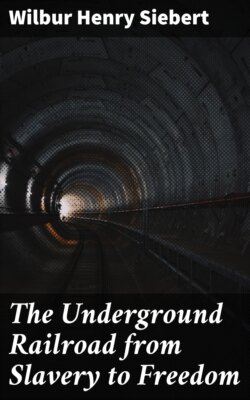Читать книгу The Underground Railroad from Slavery to Freedom - Wilbur Henry Siebert - Страница 5
На сайте Литреса книга снята с продажи.
PREFACE
ОглавлениеTable of Contents
This volume is the outgrowth of an investigation begun in 1892–1893, when the writer was giving a portion of his time to the teaching of United States history in the Ohio State University. The search for materials was carried on at intervals during several years until the mass of information, written and printed, was deemed sufficient to be subjected to the processes of analysis and generalization.
Patience and care have been required to overcome the difficulties attaching to a subject that was in an extraordinary sense a hidden one; and the author has constantly tried to observe those well-known dicta of the historian; namely, to be content with the materials discovered without making additions of his own, and to let his conclusions be defined by the facts, rather than seek to cast these "in the mould of his hypothesis."
Starting without preconceptions, the writer has been constrained to the views set forth in Chapters X and XI in regard to the real meaning and importance of the underground movement. And if it be found by the reader that these views are in any measure novel, it is hoped that the pages of this book contain evidence sufficient for their justification. There is something mysterious and inexplicable about the whole anti-slavery movement in the United States, as its history is generally recounted. According to the accepted view the anti-slavery movement of the thirties and the later decades has been considered as altogether distinct from the earlier abolition period in our history, both in principle and external features, and as separated from it by a considerable interval of time. The earlier movement is supposed to have died a natural death, and the later to have sprung into full life and vigor with the appearance of Garrison and the Liberator. Issue is made with this view in the following pages, where Macaulay's rational account of revolutions in general may, perhaps, be thought to find illustration. Macaulay says in one of his essays: "As the history of states is generally written, the greatest and most momentous revolutions seem to come upon them like supernatural inflictions, without warning or cause. But the fact is, that such revolutions are almost always the consequences of moral changes, which have gradually passed on the mass of the community, and which ordinarily proceed far before their progress is indicated by any public measure. An intimate knowledge of the domestic history of nations is therefore absolutely necessary to the prognosis of political events." Or, the essayist might have added, to a subsequent understanding of them.
It is impossible for the author to make acknowledgments to all who have contributed, directly and indirectly, to the promotion of his research. A liberal use of foot-notes suffices to reduce his obligations in part only. But, although the great balance of his indebtedness must stand against him, his special acknowledgments are due in certain quarters. The writer has to thank Professor J. Franklin Jameson of Brown University for calling his attention to a rare and important little book, which otherwise would almost certainly have escaped his notice. To Professor Eugene Wambaugh of the Harvard Law School he is indebted for the critical perusal of Chapter IX, on the Prosecutions of Underground Railroad Men—a chapter based largely on reports of cases, and involving legal points about which the layman may easily go astray. The frequent citations of the monograph on Fugitive Slaves by Mrs. Marion G. McDougall attest the general usefulness of that book in the preparation of the present work. For personal encouragement in the undertaking after the collection of materials had begun, and for assistance while the study was being put in manuscript, the author is most deeply indebted to Professor Albert Bushnell Hart, and the Seminary of American History in Harvard University, over which he and his colleague, Professor Edward Channing, preside. The proof-sheets of this book have been read by Mr. F. B. Sanborn, of Concord, Massachusetts, and, it is hardly necessary to add, have profited thereby in a way that would have been impossible had they passed under the eye of one less widely acquainted with anti-slavery times and anti-slavery people. More than to all others the author's gratitude is due to the members of his own household, without whose abiding interest and ready assistance in many ways this work could not have been carried to completion. It should be said that no responsibility for the use made of data or the conclusions drawn from them can justly be imposed upon those whose generous offices have kept these pages freer from discrepancies than they could have been otherwise.
It is a fortunate circumstance that, by the kindness of the artist, Mr. C. T. Webber, the reproduction of his painting entitled "The Underground Railroad" can appear as the frontispiece of this book. Mr. Webber was fitted by his intimate acquaintance with the Coffin family of Cincinnati, Ohio, and their remarkable record in the work of secret emancipation, to give a sympathetic delineation of the Underground Railroad in operation.
Ohio State University,
October, 1898.
THE
UNDERGROUND RAILROAD
FROM
SLAVERY TO FREEDOM
